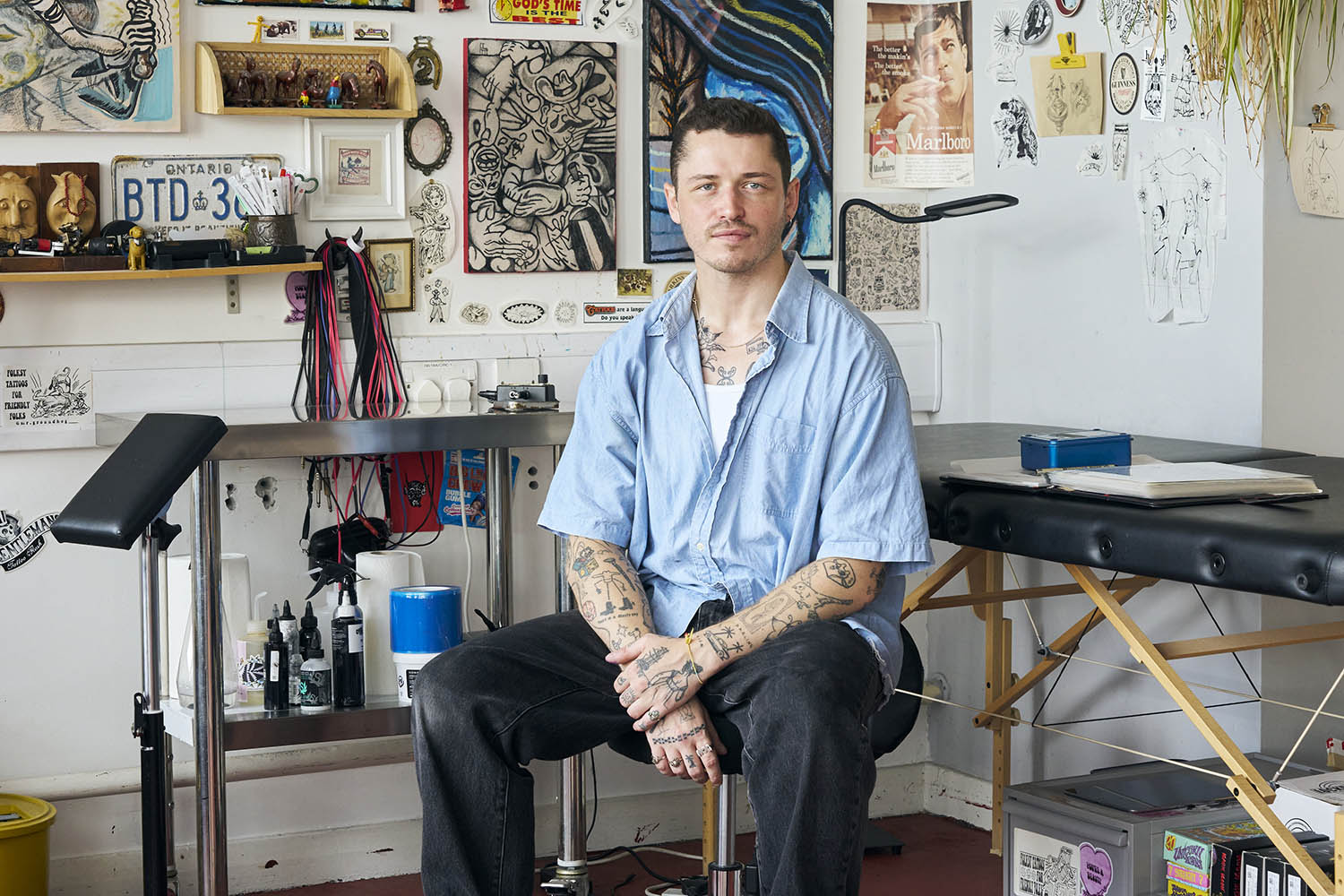Photography by Suki Dhanda
Alan, 28, works in marketing. He is lying on his back on a massage table, his extended right arm resting on a plinth while a single needle is jabbed in and out, in and out. It’s Alan’s first time being tattooed. Why here, I ask? Why this artist? “Because I’m interested in archaeology,” he says. And what are you getting tattooed? “A Sumerian tablet.”
Souvenirs is a tattoo studio in south-east London. The three-storey building in which it is housed contains units of varying size. There are writers and journalists, an accountant, a hairdresser specialising in weaves and someone who fixes trumpets and trombones. Souvenirs is an appointments-only studio, and the artists who tattoo there advertise their work through Instagram. Three of the artists use pseudonyms – Billy the Kid, Adverse Camber and Mr Groundhog – and one, Malcolm Macqueen, goes by his real name. The address and unit number are provided upon booking.
Over the early summer, I got used to dipping into the studio, chatting to the artists and clients, curious about their relationship – and about whether you can lead a creative life and still pay the bills. Macqueen is there when I arrive at 9.40am on a typical weekday, relaxing in a chair next to a leather sofa, ready for his client at 10am.
A playlist of calm, esoteric music comes from a speaker, and the light-filled studio is decorated with posters, paintings and cultural paraphernalia: masks, carvings, figurines, beer mats, old advertising placards. One sign reads: “Fuck macho bullshit forever.”
A bookcase contains titles including Bodies of Subversion, The Origins of Western Art and A Collector’s Guide to Swords, Daggers & Cutlasses. Four massage tables are positioned a few metres apart. Beside each table is an aluminium trolley containing ink, razors, petroleum jelly, clingfilm, cleaning fluids and disposable gloves.
The studio is a joint enterprise between the four friends. They run their business like a cooperative. Many tattoo studios have a principal owner who takes a slice of each artist’s fee. The philosophy at Souvenirs is practical as well as political: the artists can work as much or as little as they like, depending on demand and desire.
Most tattoo shops require artists to complete apprenticeships that enable them to work in established styles: Japanese, neo-traditional, realist, geometric. The artists at Souvenirs are self-taught; their designs – known in the industry as “flash” – are illustrative and idiosyncratic; their work does not fall squarely into any recognisable category.
At the heart of the underground tattoo scene is Instagram, where artists compete for potential clients by posting pictures and videos of their work and of themselves. The platform’s algorithm rewards the specific over the generic, the personal over the universal; artists who stand out can amass large audiences. Macqueen has 24,800 followers.
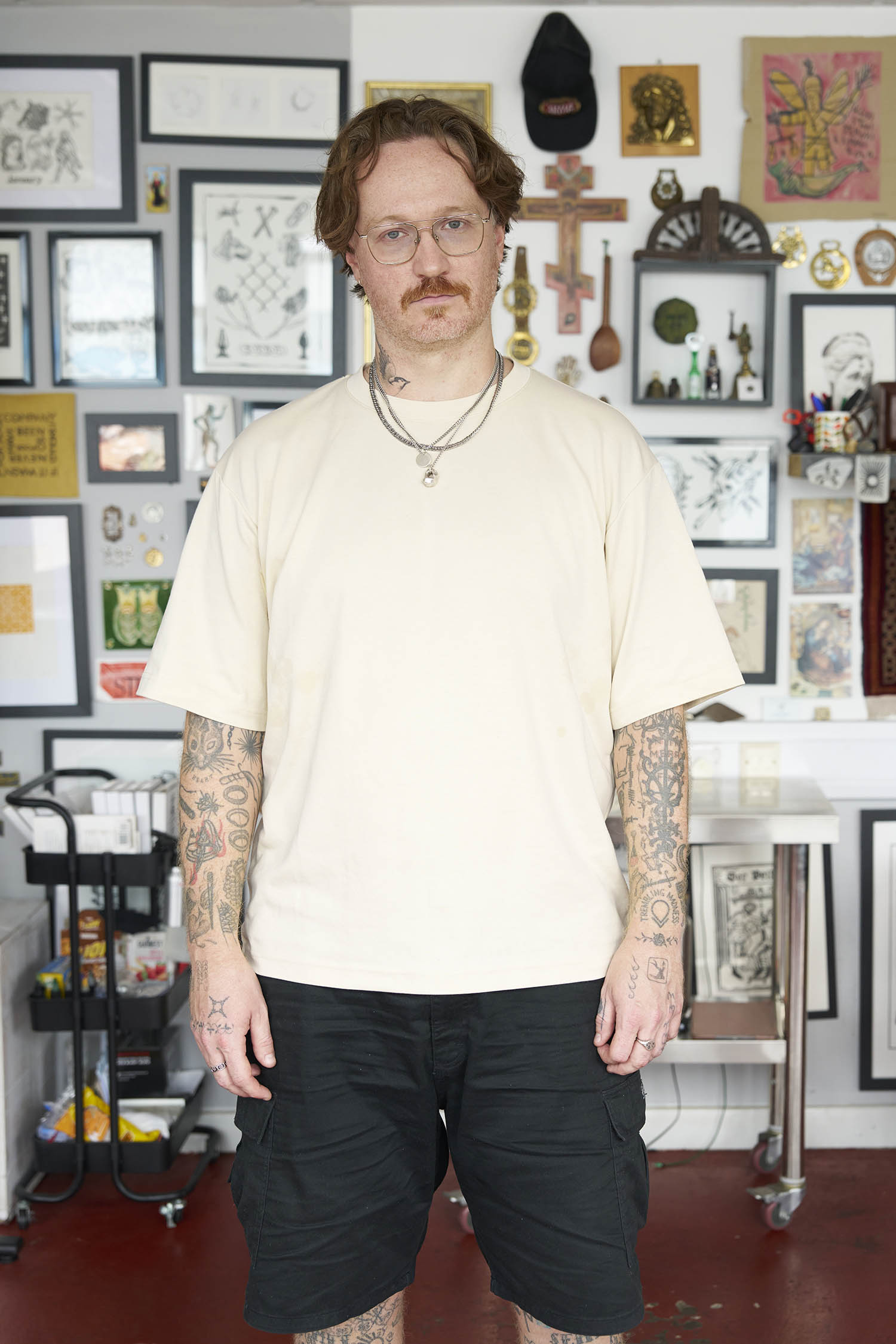
Malcolm Macqueen specialises in tattooing historical artefacts
Now 33, Macqueen grew up in the English countryside and began tattooing 10 years ago. His career seemed likely to be in teaching or academia. Then, one night at a party, someone gave him a stick-and-poke tattoo (where ink is applied with a single needle rather than a machine) and he had an epiphany. “It was a buzz,” he says, “because [the woman] who did it wasn’t a professional tattooer. And I was like: ‘Well, it’s not magic then, is it?’” He spent the rest of the summer tattooing himself.
Mothers loom large in tattoo culture, as subject or censor. Macqueen’s mum is a priest and Christian imagery was his way into tattooing. Now he specialises in tattooing historical artefacts of every kind. His designs feature medieval coins, church corbels, Mesolithic sculptures and creatures from the Bayeux tapestry. Many of his clients are teachers, archaeologists and historians; often they bring him small items – hag stones, buttons, jewellery – to turn into tattoos.
Macqueen has a strong anti-establishment sensibility (the studio contains political pamphlets with titles including A Glorious Liberty: The Ideas of the Ranters) which informs his interest in history. He’s fascinated by dissidents, from the Chartists to the Diggers, and his art champions the underdogs of Britain’s national story. It’s also a means of examining his own feelings about his nationality.
“Being British and being, you know, slightly embarrassed about British history,” he says. “Trying to understand what it means to love cask ale and butter pies and the rolling hills of Kent at the same time as not liking flag-shagging and the royal family and the Conservative party.”
Macqueen didn’t abandon his intellectual ambitions, recently finishing a PhD on the study of philosophy in prisons. “I thought that was going to be my life,” he says. “But my interest in tattooing slowly eclipsed my interest in academia. With tattooing, I can’t wait to go to work. It’s the best job in the world.”
The first client of the day is Dominic, a philanthropy adviser from New York City. He’s a Macqueen regular and is here for an all-day session. While Macqueen is busy finalising designs on an iPad, Dominic, a thoughtful, softly spoken thirtysomething, tells me that he collects tattoos like art. “If Malcolm made paintings, I would buy them.”
Dominic hand-poked a bracelet design on his own wrist and experienced the process as a kind of therapy. “Tattooing is part of my spirituality,” he says. Later, when he removes his hoodie and T-shirt before getting his torso tattooed, I see that he has a large back tattoo based on Dante’s Inferno.
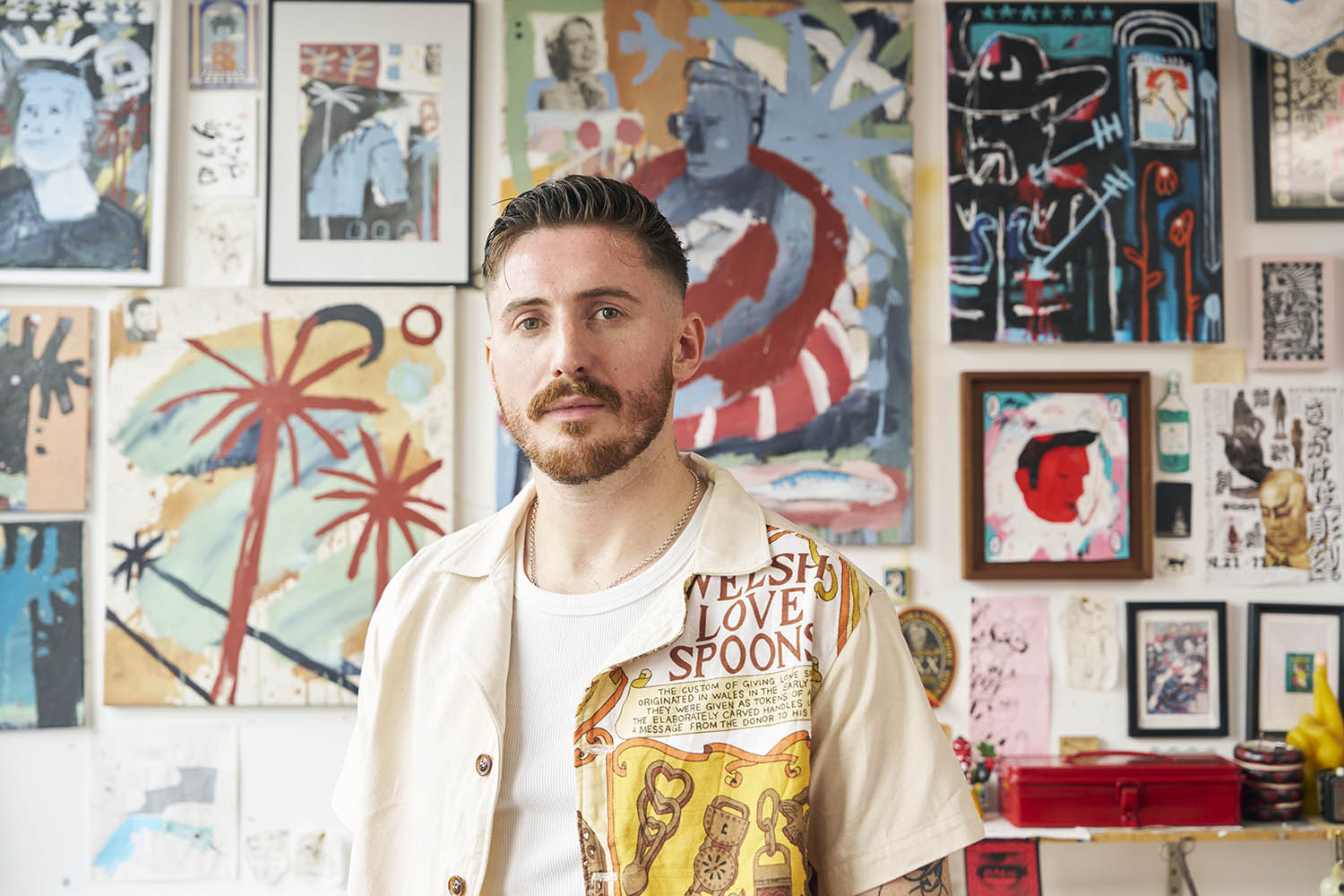
Billy Bagilhole, AKA Billy the Kid, gained thousands of Instagram followers when he tattooed actor Ella Purnell last year
Chris Woodhead, AKA Adverse Camber, arrives just before 11am, followed soon after by his client Stu, a young man who works in finance. Stu’s been tattooed here before; today, he’s getting a custom design based on a photograph he took on holiday in the US. First, the artwork is printed on paper in various sizes for Stu to hold up against his body.
Once he’s decided on size and a rough location – his upper leg – the area is cleaned and shaved, a stencil thermal-printed and applied; Stu stands in front of a full-length mirror, deciding whether the design is negatively affected by movement.
No, it’s fine, they decide, and soon Stu is in position – legs flat on a freshly disinfected massage table, back at 45 degrees, one side of his shorts rolled up – while Woodhead readies his machine. On the station next to him, a shirtless Dominic – himself shaved and stencilled – is lying on his back, ready for Macqueen to stick-and-poke him. (Of the four artists, Macqueen is the only one who uses the stick-and-poke method rather than a machine: “It’s the same setup, except there’s no power supply,” he says. “Just like the difference between hand embroidery and a sewing machine.”)
It’s late morning, the sun is out and two men, one who sells financial services, the other who redistributes wealth, are about to be tattooed.
Woodhead, 38, grew up in St Ives in Cornwall. He started playing guitar in bands aged 18 but was unable to make a living from it. He moved to London and took a job in hospitality, still dreaming of making it as a musician. He became a well-known face on the tattoo scene when he befriended an aspiring artist who used him as a canvas, tattooing him more than 500 times. Aged 27, the moment he had longed for arrived: he became a guitarist in the singer-songwriter Jamie T’s band, his first paid music job.
He vowed never to return to joyless work, and when his music career hit a dry spell, he learned to tattoo for himself. (Woodhead made headlines during the Covid pandemic for tattooing his own body every day during lockdown.) “I wasn’t an illustrator, I didn’t go to art school,” he says. “I wanted to be a tattoo artist because I loved getting tattooed.” He is the most heavily inked of the artists (he likes to say that he looks like a piece of blue cheese) and the most animated.
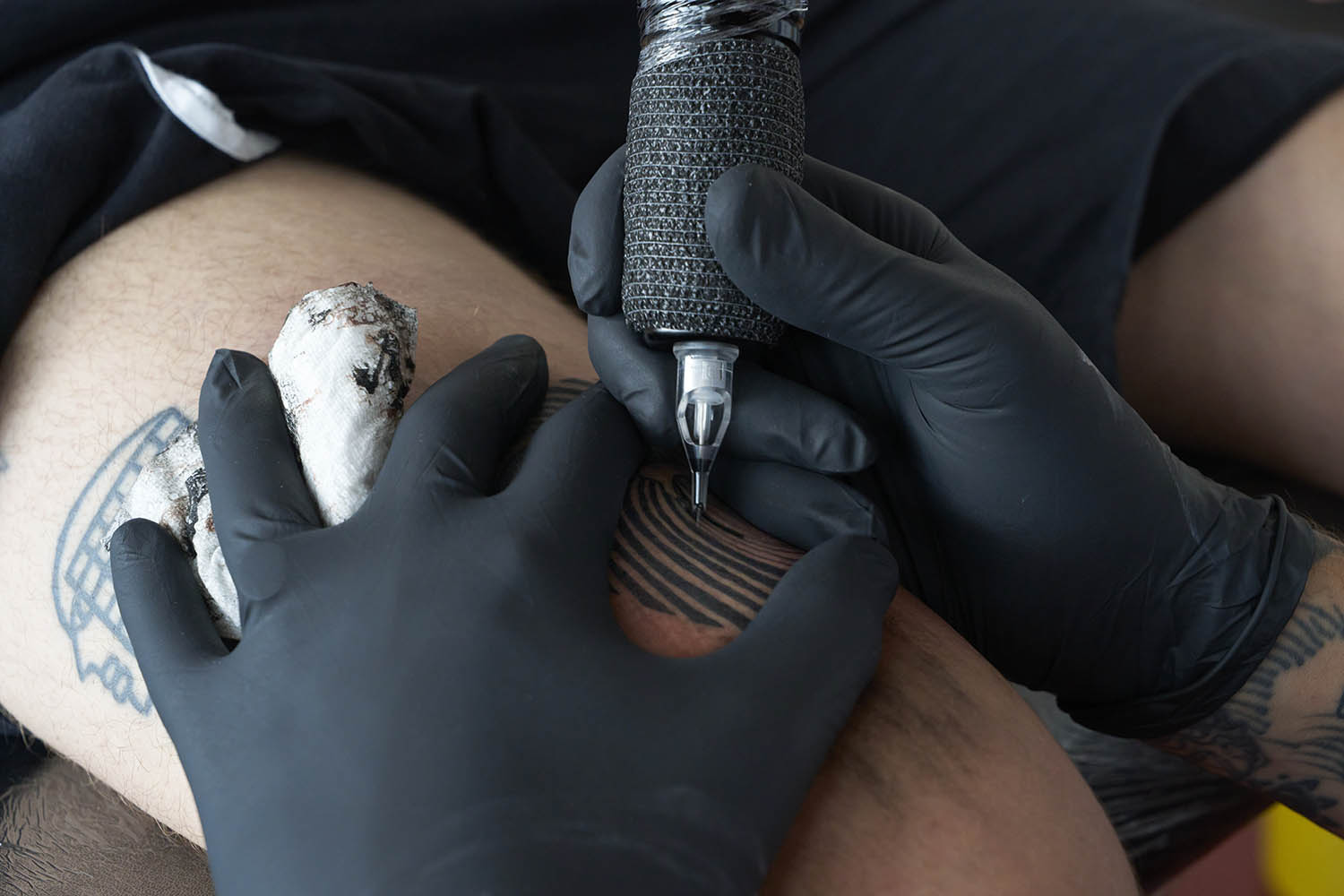
Billy the Kid at work
Woodhead’s designs are a mix of original drawings and references to pop culture. Often, they’re things he simply finds funny. His work reflects an irreverent style of tattoo art inspired by graffiti and sometimes referred to as “ignorant”. Woodhead puts his success on Instagram (29,000 followers) down to his sense of humour. One of his posts, of a palm tattoo, the most painful area to get tattooed, reads: “Ruined someone’s day today. Was fun.”
Today he is applying second skin – a thin transparent bandage – to Stu’s leg, as Freddie, a young Londoner who works in radio, arrives. Freddie is getting two tattoos: the word “unlucky” on one arm and the words “time for bed” inside a heart outline on the other. Talk turns to the weekend. “I’ve got my son, so I’m going to see Lilo & Stitch,” says Woodhead. “Me too!” admits Freddie, and both men burst out laughing.
From Souvenirs’s inception in November 2022, cultivating an environment in which everyone feels comfortable has been a priority. “A lot of old-school tattoo studios were very intimidating,” Woodhead says. When he was 20, he had a particularly bad experience at one parlour. “They ridiculed me,” he says, “making me feel embarrassed of my existing tattoos. It was fucking horrendous. ”
Just before 1pm, a young woman arrives. She’s wearing shorts and has a lot of leg tattoos. There’s a moment of confusion: “Er, who are you here to see?”
“Oh yes,” says Woodhead, sheepishly, when it turns out she’s here to see him. Victoria is from Germany and is in London for the weekend. She has been tattooed by Woodhead before, a rat on her leg (“I knew I recognised that leg,” Woodhead says), and today she’s getting another leg tattoo – of a female dancer performing a grand jeté.
Woodhead finishes up with Freddie, asks him to pose for photos for Instagram behind an LED ring light, and then they settle up. “Call it another hundred,” says Woodhead; Freddie will have already paid a small deposit to secure his appointment.
Conversation with Victoria takes unexpected turns. Is it still OK to like Lemmy from Motörhead even though he collected Nazi memorabilia? she wonders. “He made having a massive wart on your face cool,” Woodhead offers.
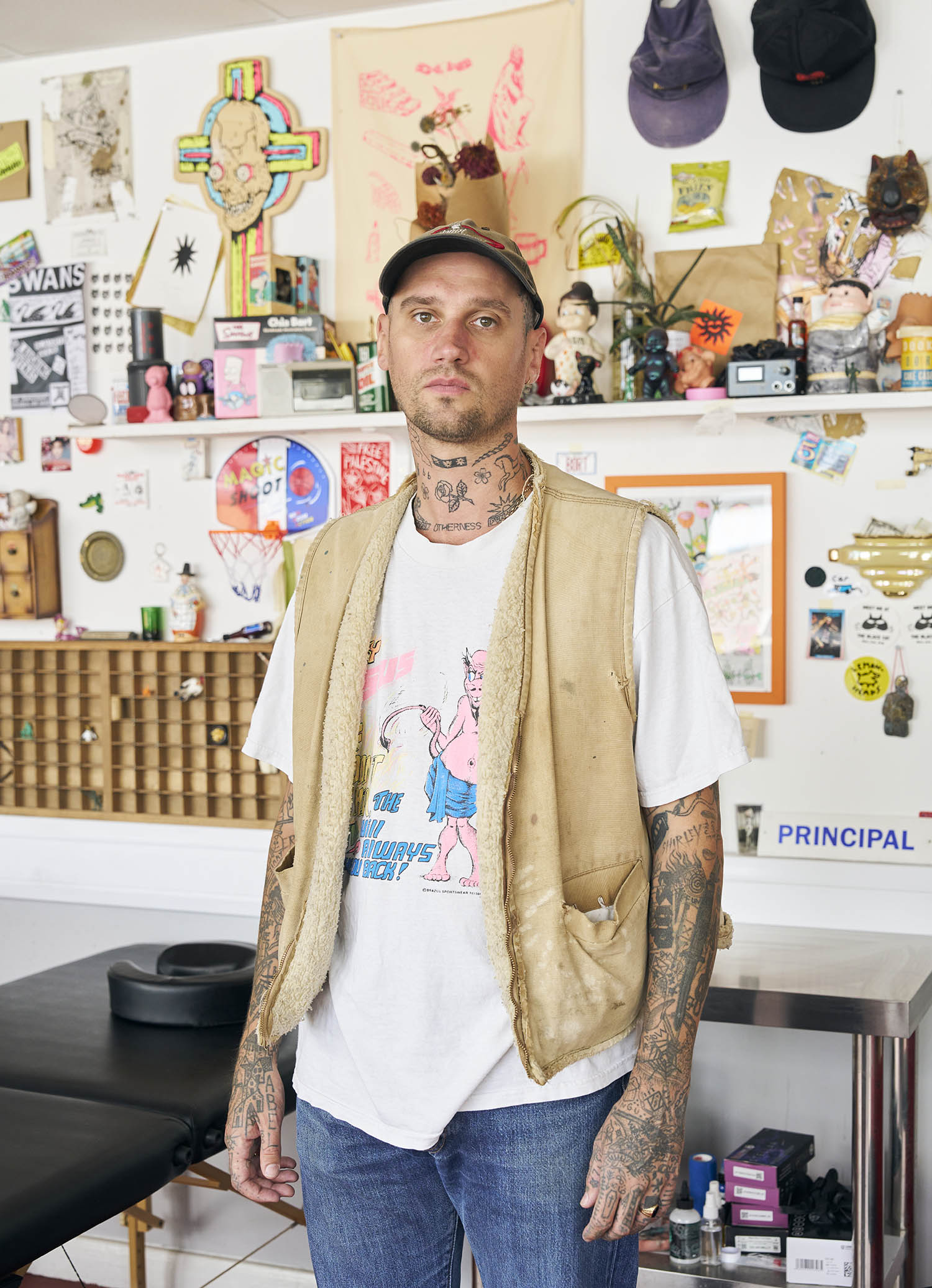
Chris Woodhead, AKA Adverse Camber, has more than 500 tattoos
Macqueen removes his head torch; Dominic’s first tattoo is finished (he opted for two large rectangles containing details of Greek statues). Temporary clingfilm is applied and Dominic departs in search of some lunch while Macqueen microwaves a homemade meal. Woodhead is done for the day, and after photographing Victoria and recommending some bars in Hackney, they both leave.
Graeme Miller, AKA Mr Groundhog, has been in the studio for about an hour, preparing for his only client of the day, Nicole – a Canadian, like Miller. She’s a regular and is returning today for three custom tattoos – a cupid, a pair of dice wearing a cowboy hat and a newlywed couple in a New York taxicab. The first stencil is applied, and Nicole gets into position. Dominic, having returned for his second tattoo, is soon back on the slab too. Without the madcap energy of Woodhead, the afternoon is a sleepy affair: the clients lie still, open windows invite a gentle breeze, dub reggae streams from the speaker. Tattooing as meditation.
The following day, I arrive at 10am to be greeted by Macqueen and Woodhead. The first client is Flossy, 27, who says she’s a butcher and a chef. In fact, when I look her up later, she’s a former fine art dealer who quit her job to start an offal business. She has several tastefully arranged tattoos. On one arm is the word “WOOF” (“because I like saying it”); on the back of each leg “RATTUS” (Latin for “rat”).
Flossy was 19 when she got her first tattoo. It was at an art fair, and she was getting a circle on her arm, but halfway through she started convulsing and passed out. The artist didn’t want to carry on, telling her to come back the next day. Flossy has lots of piercings, in both ears and in her nose. Today she’s getting symmetrical horses on her arms and symmetrical swallows on her legs.
Some clients claim to enjoy the pain of being tattooed; some even moan in pleasure. Most downplay the discomfort, occasionally to a ruinous degree. Macqueen recalls one experience of a fainter: “The guy was heavily tattooed, so I was like: ‘He’ll be fine, he can handle it.’ He turned up hungover and he was getting his knees tattooed. He said something like: ‘I’m feeling quite light-headed.’ And I said: ‘OK, cool, we can stop.’ And he said: ‘No, no, I’ll take a break in 10 minutes.’ So I’m hammering away at his knee, and he was like: ‘Yep, buddy, I’m going.’ He fell forwards and I caught him by the forehead.”
Miller once had a client pass out before he had even begun. “The studio where I used to work would take emergency details as you walk in,” he says. “And this guy was out for, like, five minutes, so I started getting concerned. Eventually, I called his mum, and I was like: ‘Hi, I have your son here. He’s about to get a tattoo and he’s completely unconscious. Is this something that happens?’ And she’s like: ‘What the fuck? He’s getting a tattoo? He promised he’d never do this.’ And then the guy woke up, while I’m on the phone, and he’s like: ‘You’re not calling my mum, are you?’”
At another table, Billy Bagilhole, AKA Billy the Kid, has arrived and is printing designs for Luke, 28, a data scientist who lives in Stoke Newington, north London. One is of a mysterious figure wearing a crown (Bagilhole says he doodled this on to a piece of paper while he was on the phone to a spam caller); another, of a creature sticking its tongue out, comes with celebrity approval. Last year, Bagilhole tattooed the design for the actor Ella Purnell, gaining thousands of new followers in the process. “Suddenly, I had loads of clients asking for the same design in the exact same location,” says Bagilhole.
Tattoos are their own advertisement, and self-taught artists regularly help one another out by trading tattoos. They also tattoo themselves. “I call my left arm my pub arm,” Bagilhole tells me. “I’ll be sat in a beer garden, and someone will see the sun tattoo on my hand and ask where I got it. I’ll tell them that I did it and how to book in. Once, I was on a flight to Japan and the guy in the seat next to me could see me working on some drawings on my iPad and he booked in with me on the flight.”
Bagilhole, 30, spent his early years on a dairy farm on the Llŷn peninsula in north Wales, and in an area of rural Spain that was once used to shoot spaghetti westerns. His father, Robin Bagilhole, who died when Billy was six, was an artist, and Billy grew up surrounded by his paintings and prints.
Billy always wanted to be a painter himself. After graduating from Chelsea College of Arts in 2017, he took a job in hospitality, painting when he could, and using Instagram to attract the attention of galleries. Aged 23, he started getting tattoos. He taught himself to tattoo watching YouTube videos. When he tattooed elements of his paintings on to his legs, he discovered that other people wanted them too. In August 2020, he created an Instagram account for his tattooing, calling it Billy the Kid, a reference to the cowboy imagery that informs many of his paintings.
Tattooing was a way of giving Bagilhole the time and money to paint. But today the two art forms are inseparable, each relying on the other. Last December, Bagilhole’s work was included in a group exhibition at the Saatchi Gallery, and in March, Shoreditch House unveiled a new permanent collection of 30 of his paintings. His Billy the Kid account, meanwhile, has 33,000 followers.
A couple of hours later and an energised Luke is clearly delighted with his tattoos. Since it’s Luke’s first time, Bagilhole explains the aftercare procedure in detail, advising him to keep the second skin on for 2-3 days. “When you take it off, it will hurt,” he says. “It will look gross. If stuff seeps out of the wrap, don’t worry about it, just leave it alone.” This warning causes Miller to launch into ghoulish tales of tattoos that didn’t heal well.
The fourth partner at Souvenirs, Miller, 27, was seemingly born to tattoo: “This is the only thing in the world that I will keep doing after the revolution.” He was born in Halifax, Nova Scotia, and always loved to draw, often doodling on his arms during class. Shortly after his family moved to London, he began tattooing himself with a needle and a ballpoint pen, covering any spaces he could hide.
He ended up doing a fine art degree but his future, he quickly realised, was decided. At university in Leeds, surrounded by art students who wanted cheap stick-and-poke tattoos, Miller was able to hone his craft; his dorm room became his first studio.
Today, Miller uses a machine to tattoo – “folksy tattoos for friendly folks” is his pitch – and his Mr Groundhog Instagram account has 24,000 followers. In the studio, Miller is unfailingly polite. His body, however, tells its own story. A tattoo on his arm, by Woodhead, reads “HOT SEX TEX-MEX”; another, tattooed while on holiday in Tenerife, reads “Tenerife”. “Yeah, I’m covered in small patchwork tattoos,” he says. “Most of them are very silly. There are little memories, little marks of time. I’m really blase about it. I will get almost anything. We put some boobies on my arm. You know, I’ve got people’s names that I don’t even know…”
There must be occasions, I suggest, when the artists have doubts about whether a particular tattoo is in the client’s best interests.
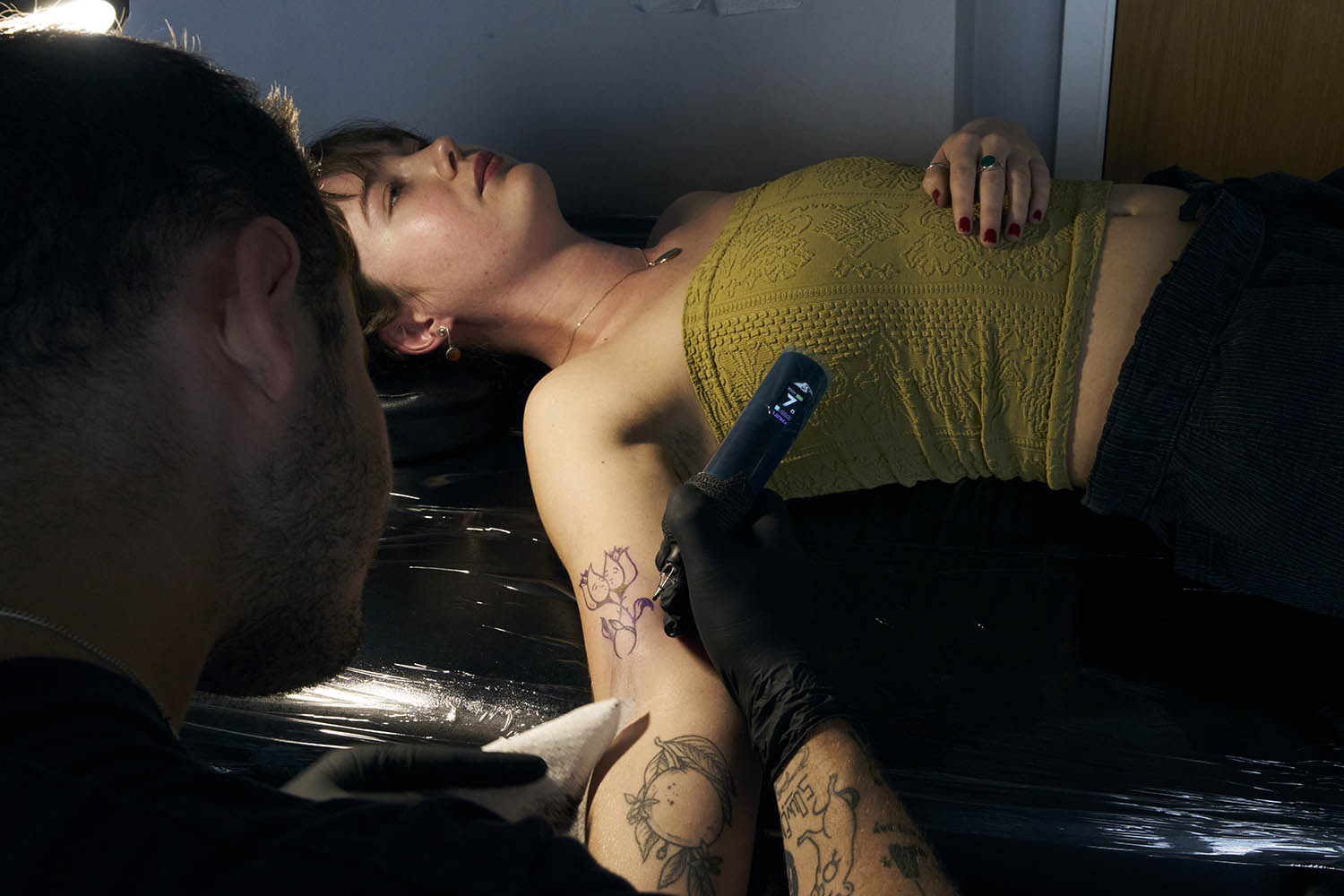
Mr Groundhog applying a tattoo
“They normally get filtered out before they get to the studio,” says Macqueen. “We’re not a walk-in shop. People don’t turn up pissed. If they’ve had to wait three weeks, a stupid decision has probably been tempered a bit.”
Woodhead recalls a potentially troubling request from a client he’d tattooed before: “He messaged me asking if I would be happy to tattoo his face. I said: ‘I’m not sure, you’re quite young.’ But he said he’d already started getting his face tattooed. He’d had his girlfriend’s name and a few other things. So I was like: ‘Yeah, fuck it. I’ll do your face. You know, if you’ve already started, I’ll carry on.’ So I did a sun and a massive flower. And then, at the end of the session – I’d done six tattoos on him, including his palm – he said: ‘Can I just get one more? Could I get Courage the Cowardly Dog?’ I was like: ‘Yeah, I can draw one up.’ So I drew it and asked him where he wanted it. And he goes: ‘Er, might as well whack it on my face.’”
Souvenirs is not unique. In London, there are many underground artists working in parallel with traditional tattoo shops. Recently, Miller was guest-tattooing in Cardiff, Macqueen in Manchester, Bagilhole in Vienna; this summer, Woodhead will tattoo in Paris. There are more tattoo artists and more tattooed people (26% of UK adults, according to a YouGov poll), than ever before. But the cultural significance of 14 million Britons decorating their bodies with permanent art is seldom explored.
“Quite a lot of tattooing is craft,” says Macqueen. “It’s a commission, and it involves an active participant. In some ways, that makes it almost like a service industry rather than an art. Plus, tattoos aren’t commodifiable, so the art market can’t make any money from them.”
“There’s a company in LA that will extract your skin when you die,” says Miller, “so you can frame it for your family. But that’s fucking weird. The whole point is that it lives and dies with you.”
Alan is the final client of the day. He has been following Macqueen on Instagram for a while, steadily building up the courage to get his first tattoo – the Sumerian tablet, dating back to Mesopotamia about 2900BC and depicting the first language for which written evidence exists. He seems excited, maybe a little nervous, as Macqueen begins prodding. History, you might say, in the making.
